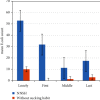Influence of Nonnutritive Sucking Habits on the Oral Carriage of Escherichia coli
- PMID: 36419951
- PMCID: PMC9678441
- DOI: 10.1155/2022/1216727
Influence of Nonnutritive Sucking Habits on the Oral Carriage of Escherichia coli
Abstract
Objectives: This study aimed to evaluate the impact of nonnutritive sucking habits on the presence of oral Escherichia coli.
Methods: One hundred and twenty children aged 3-5 years old were enrolled in the present case-control study, as follows: 60 children with continuous pacifier and thumb sucking habits (study group) and 60 children without any sucking habits (control group). The children in the two groups were matched in terms of age and gender. Information was gathered from the parents concerning their children using a special sheet. Sterile swabs were taken from both groups and cultured on agar plates. Then, they were subjected to further biochemical tests to identify E. coli species. The mean of the E. coli count was determined for each child. Descriptive, independent t-test and chi-square test statistics were used. The level of significance was set at p < 0.05.
Results: The presence of nonnutritive sucking habits was related to a higher carriage of E. coli among children.
Conclusion: Nonnutritive sucking habits may act as a predisposing factor that enhances the colonization of oral E. coli.
Copyright © 2022 Aseel Al Haidar.
Conflict of interest statement
The author declares that there are no conflicts of interest.
Figures
Similar articles
-
Nonnutritive sucking habits among preschool-aged children.J Pediatr (Rio J). 2009 Sep-Oct;85(5):408-14. doi: 10.2223/JPED.1926. J Pediatr (Rio J). 2009. PMID: 19830351 English, Portuguese.
-
Children using Day Nurseries' Facilities can be Associated with more Risk to Nonnutritive Sucking Habits.J Contemp Dent Pract. 2016 Sep 1;17(9):721-727. doi: 10.5005/jp-journals-10024-1919. J Contemp Dent Pract. 2016. PMID: 27733714
-
Changes in the prevalence of nonnutritive sucking patterns in the first 8 years of life.Am J Orthod Dentofacial Orthop. 2006 Jul;130(1):31-6. doi: 10.1016/j.ajodo.2004.11.033. Am J Orthod Dentofacial Orthop. 2006. PMID: 16849069
-
Nutritive and nonnutritive sucking habits: a review.ASDC J Dent Child. 1996 Sep-Oct;63(5):321-7. ASDC J Dent Child. 1996. PMID: 8958342 Review.
-
The use of nonnutritive sucking to facilitate oral feeding in a term infant: a single case study.J Pediatr Nurs. 2012 Dec;27(6):700-6. doi: 10.1016/j.pedn.2012.01.006. Epub 2012 Feb 22. J Pediatr Nurs. 2012. PMID: 22366642 Review.
Cited by
-
Clinical assessment of deleterious oral habits and dental caries-periodontal parameters among Turkish twins.J Dent Sci. 2023 Oct;18(4):1859-1866. doi: 10.1016/j.jds.2023.05.009. Epub 2023 May 19. J Dent Sci. 2023. PMID: 37799885 Free PMC article.
References
-
- De Carvalho F. M., Rocha Valadas L. A., Sá Nogueira J. A., et al. Influence of breastfeeding and deleterious oral habits in malocclusions in children. Journal of Young Pharmacists . 2021;13(2):172–177. doi: 10.5530/jyp.2021.13.35. - DOI
-
- Muzaffar M., Imran Dar M., Fayaz A. Prevalence of deleterious oral habits among 4 to 6 year old preschool children. Journal of Advanced Medical and Dental Sciences Research . 2022;10(3):98–101.
-
- Katz C. R. T., Souto J. R. S., Feitosa S. V. H. S., Souza A. S., Zisman M., Rosenblatt A. Harmful oral habits: a multidisciplinary approach. Arq Odontol . 2002;38:35–42.
-
- Rani M. S. Synopsis of Orthodontics . 2. New Delhi, India: All India publisher and Distributors; 1998.
LinkOut - more resources
Full Text Sources




